Noise Suppression and Edge Preservation for Low-Dose COVID-19 CT Images Using NLM and Method Noise Thresholding in Shearlet Domain
Abstract
1. Introduction
2. Preliminaries
2.1. NSST or Non-Subsampled Shearlet Transform
2.2. Non-Local Mean (NLM)
3. Proposed Methodology
Proposed Thresholding Function
| Algorithm 1: CT image denoising. |
| Step 1: Firstly, read input noisy CT image. Step 2: Non-subsampled shearlet transform is applied to both noisy images, which divides the image into two parts: a. Approximation part (H) b. Detailed part (D) Step 3: Apply k and l directional circular shift to obtain n high-frequency sub-bands of both input images. Step 4: Perform NLM filter on both approximation part. Step 5: Perform average operation on the outcomes of Step 4. Step 6: For all levels in high-frequency sub-bands of both input images: (a) Calculate the threshold value (b) Apply shrinkage rule using Equation (16) Step 7: To obtain an enhanced high-frequency sub-band, calculate the weighted average based on patch variance on the outcome of Step 6: where = , var−1 (.) represents the inverse of threshold, and H(k,l)s is the final threshold value. Step 8: To obtain the final output image, perform the inverse of the circular shift using the outcome of Step 5 and Step 7: |
4. Results and Discussion
4.1. Comparative Analysis
4.2. Performance Metrics
5. Conclusions
Author Contributions
Funding
Institutional Review Board Statement
Informed Consent Statement
Data Availability Statement
Conflicts of Interest
References
- Shi, F.; Wang, J.; Shi, J.; Wu, Z.; Wang, Q.; Tang, Z.; He, K.; Shi, Y.; Shen, D. Review of artificial intelligence techniques in imaging data acquisition, segmentation and diagnosis for covid-19. IEEE Rev. Biomed. Eng. 2021, 14, 4–15. [Google Scholar] [CrossRef]
- Dong, D.; Tang, Z.; Wang, S.; Hui, H.; Gong, L.; Lu, Y.; Xue, Z.; Liao, H.; Chen, F.; Yang, F.; et al. The role of imaging in the detection and management of COVID-19: A review. IEEE Rev. Biomed. Eng. 2021, 14, 16–29. [Google Scholar] [CrossRef]
- Ulhaq, A.; Khan, A.; Gomes, D.; Paul, M. Computer Vision for COVID-19 Control: A Survey. arXiv 2020, arXiv:2004.09420. [Google Scholar] [CrossRef]
- Li, K.; Wu, X.; Zhong, Y.; Qin, W.; Zhang, Z. Diagnostic performance of CT and its key signs for COVID-19: A systematic review and meta-analysis. medRxiv 2020. [Google Scholar] [CrossRef]
- Nair, A.; Rodrigues, J.C.L.; Hare, S.; Edey, A.; Devaraj, A.; Jacob, J.; Robinson, G. A British Society of Thoracic Imaging statement: Considerations in designing local imaging diagnostic algorithms for the COVID-19 pandemic. Clin. Radiol. 2020, 75, 329–334. [Google Scholar] [CrossRef]
- Huang, Q.; Li, J.; Lyu, S.; Liang, W.; Yang, R.; Zhang, R.; Chen, F. COVID-19 associated kidney impairment in adult: Qualitative and quantitative analyses with non-enhanced CT on admission. Eur. J. Radiol. 2020, 2020, 109240. [Google Scholar] [CrossRef]
- Hamilton, N.E.; Adam, G.H.; Ifan, D.L.; Lam, S.S.; Johnson, K.; Vedwan, K.A.G.; Abbas, A. Diagnostic utility of additional whole-chest CT as part of an acute abdominal pain CT imaging pathway during the COVID-19 pandemic. Clin. Radiol. 2020, 75, 592–598. [Google Scholar] [CrossRef]
- Jiang, M.; Chen, P.; Li, T.; Tang, Y.; Chen, X.; Chen, X.; Ruan, X. Chest CT imaging features and clinical outcome of coronavirus disease 2019 (COVID-19): A single-center case study in Ningbo, China. Clin. Imaging 2021, 69, 27–32. [Google Scholar] [CrossRef]
- Bao, C.; Liu, X.; Zhang, H.; Li, Y.; Liu, J. Coronavirus disease 2019 (COVID-19) CT findings: A systematic review and meta-analysis. J. Am. Coll. Radiol. 2020, 17, 701. [Google Scholar] [CrossRef]
- Diwakar, M.; Singh, P. CT image denoising using multivariate model and its method noise thresholding in non-subsampled shearlet domain. Biomed. Signal Processing Control 2020, 57, 101754. [Google Scholar] [CrossRef]
- Routray, S.; Malla, P.P.; Sharma, S.K.; Panda, S.K.; Palai, G. A new image denoising framework using bilateral filtering based non-subsampled shearlet transform. Optik 2020, 216, 164903. [Google Scholar] [CrossRef]
- Goyal, B.; Dogra, A.; Agrawal, S.; Sohi, B.S. Two-dimensional gray scale image denoising via morphological operations in NSST domain and bitonic filtering. Future Gener. Comput. Syst. 2018, 82, 158–175. [Google Scholar] [CrossRef]
- Panigrahi, S.K.; Gupta, S.; Sahu, P.K. Curvelet-based multiscale denoising using non-local means and guided image filter. IET Image Processing 2018, 12, 909–918. [Google Scholar] [CrossRef]
- Liu, X.; Tang, Y.; Yang, Y. Primal-dual algorithm to solve the constrained second-order total generalized variational model for image denoising. J. Electron. Imaging 2019, 28, 043017. [Google Scholar] [CrossRef]
- Dhabal, S.; Chakrabarti, R.; Mishra, N.S.; Venkateswaran, P. An improved image denoising technique using differential evolution-based salp swarm algorithm. Soft Computing 2020, 25, 1941–1961. [Google Scholar] [CrossRef]
- Liu, Y.; Li, S.; Zhang, H. Multibaseline Interferometric Phase Denoising Based on Kurtosis in the NSST Domain. Sensors 2020, 20, 551. [Google Scholar] [CrossRef]
- Al-Mefty, O.; Kersh, J.E.; Routh, A.; Smith, R.R. The long-term side effects of radiation therapy for benign brain tumors in adults. J. Neurosurg. 1990, 73, 502–512. [Google Scholar] [CrossRef]
- Kursun, S.; Öztas, B.; Atas, H.; Tastekin, M. Effects of X-rays and magnetic resonance imaging on mercury release from dental amalgam into artificial saliva. Oral Radiol. 2014, 30, 142–146. [Google Scholar] [CrossRef]
- Thanh, D.; Prasath, S. A review on CT and X-ray images denoising methods. Informatica 2019, 43, 151–159. [Google Scholar] [CrossRef]
- Fan, L.; Zhang, F.; Fan, H.; Zhang, C. Brief review of image denoising techniques. Vis. Comput. Ind. Biomed. Art 2019, 2, 7. [Google Scholar] [CrossRef]
- Tang, N.; Zhao, X.; Li, Y.; Zhu, D. Adaptive threshold shearlet transform for surface microseismic data denoising. J. Appl. Geophys. 2018, 153, 64–74. [Google Scholar] [CrossRef]
- Xu, W.; Tang, C.; Gu, F.; Cheng, J. Combination of oriented partial differential equation and shearlet transform for denoising in electronic speckle pattern interferometry fringe patterns. Appl. Opt. 2017, 56, 2843–2850. [Google Scholar] [CrossRef] [PubMed]
- Gibert, X.; Patel, V.M.; Labate, D.; Chellappa, R. Discrete shearlet transform on GPU with applications in anomaly detection and denoising. EURASIP J. Adv. Signal Processing 2014, 2014, 64. [Google Scholar] [CrossRef]
- Yang, H.Y.; Wang, X.Y.; Niu, P.P.; Liu, Y.C. Image denoising using nonsubsampled shearlet transform and twin support vector machines. Neural Netw. 2014, 57, 152–165. [Google Scholar] [CrossRef] [PubMed]
- Shahdoosti, H.R.; Khayat, O. Image denoising using sparse representation classification and non-subsampled shearlet transform. Signal Image Video Process. 2016, 10, 1081–1087. [Google Scholar] [CrossRef]
- Zhang, C.; van der Baan, M. Multicomponent microseismic data denoising by 3D shearlet transform. Geophysics 2018, 83, A45–A51. [Google Scholar] [CrossRef]
- Wang, J.; Bao, Y.; Wen, Y.; Lu, H.; Luo, H.; Xiang, Y.; Qian, D. Prior-Attention Residual Learning for More Discriminative COVID-19 Screening in CT Images. IEEE Trans. Med. Imaging 2020, 39, 2572–2583. [Google Scholar] [CrossRef]
- Hu, S.; Gao, Y.; Niu, Z.; Jiang, Y.; Li, L.; Xiao, X.; Yang, G. Weakly supervised deep learning for COVID-19 infection detection and classification from ct images. IEEE Access 2020, 8, 118869–118883. [Google Scholar] [CrossRef]
- Sun, L.; Mo, Z.; Yan, F.; Xia, L.; Shan, F.; Ding, Z.; Shen, D. Adaptive feature selection guided deep forest for COVID-19 classification with chest ct. IEEE J. Biomed. Health Inform. 2020, 24, 2798–2805. [Google Scholar] [CrossRef]
- Shiri, I.; Akhavanallaf, A.; Sanaat, A.; Salimi, Y.; Askari, D.; Mansouri, Z.; Zaidi, H. Ultra-low-dose chest CT imaging of COVID-19 patients using a deep residual neural network. Eur. Radiol. 2020, 31, 1420–1432. [Google Scholar] [CrossRef]
- Zhao, W.; Zhong, Z.; Xie, X.; Yu, Q.; Liu, J. Relation between chest CT findings and clinical conditions of coronavirus disease (COVID-19) pneumonia: A multicenter study. Am. J. Roentgenol. 2020, 214, 1072–1077. [Google Scholar] [CrossRef] [PubMed]
- Tan, Y.; Wang, X.; Yang, W.; Cheng, Z.; Cao, Q.; Pan, A.; Qin, L. COVID-19 patients with progressive and non-progressive CT manifestations. Radiol. Infect. Dis. 2020, 7, 97–105. [Google Scholar] [CrossRef] [PubMed]
- Abolyazid, S.; Alshareef, S.; Abdullah, N.; Khalil, A.; Hamza, N.; Salem, A. COVID-19 pneumonia identified by CT of the abdomen: A report of three emergency patients presenting with abdominal pain. Radiol. Case Rep. 2020, 15, 2098–2103. [Google Scholar] [CrossRef] [PubMed]
- Ambrosetti, M.C.; Battocchio, G.; Zamboni, G.A.; Fava, C.; Tacconelli, E.; Mansueto, G. Rapid onset of bronchiectasis in COVID-19 Pneumonia: Two cases studied with CT. Radiol. Case Rep. 2020, 15, 2098–2103. [Google Scholar] [CrossRef]
- Johnson, L.N.; Vesselle, H. COVID-19 in an asymptomatic patient undergoing FDG PET/CT. Radiol. Case Rep. 2020, 15, 1809–1812. [Google Scholar] [CrossRef] [PubMed]
- Ferrando-Castagnetto, F.; Wakfie-Corieh, C.G.; García, A.M.B.; García-Esquinas, M.G.; Caro, R.M.C.; Delgado, J.L.C. Incidental and simultaneous finding of pulmonary thrombus and COVID-19 pneumonia in a cancer patient derived to 18F-FDG PET/CT. New pathophysiological insights from hybrid imaging. Radiol. Case Rep. 2020, 15, 1803–1805. [Google Scholar] [CrossRef]
- Liu, H.; Liu, F.; Li, J.; Zhang, T.; Wang, D.; Lan, W. Clinical and CT imaging features of the COVID-19 pneumonia: Focus on pregnant women and children. J. Infect. 2020, 80, e7–e13. [Google Scholar] [CrossRef]
- Wang, K.; Kang, S.; Tian, R.; Zhang, X.; Wang, Y. Imaging manifestations and diagnostic value of chest CT of coronavirus disease 2019 (COVID-19) in the Xiaogan area. Clin. Radiol. 2020, 75, 341–347. [Google Scholar] [CrossRef]
- Brogna, B.; Bignardi, E.; Salvatore, P.; Alberigo, M.; Brogna, C.; Megliola, A.; Musto, L. Unusual presentations of COVID-19 pneumonia on CT scans with spontaneous pneumomediastinum and loculated pneumothorax: A report of two cases and a review of the literature. Heart Lung 2020, 49, 864–868. [Google Scholar] [CrossRef]
- Ardakani, A.A.; Kanafi, A.R.; Acharya, U.R.; Khadem, N.; Mohammadi, A. Application of deep learning technique to manage COVID-19 in routine clinical practice using CT images: Results of 10 convolutional neural networks. Comput. Biol. Med. 2020, 212, 103795. [Google Scholar] [CrossRef]
- Skalidis, I.; Nguyen, V.K.; Bothorel, H.; Poli, L.; Da Costa, R.R.; Younossian, A.B.; Kherad, O. Unenhanced computed tomography (CT) utility for triage at the emergency department during COVID-19 pandemic. Am. J. Emerg. Med. 2020, 46, 260–265. [Google Scholar] [CrossRef] [PubMed]
- Wang, G.; Liu, X.; Li, C.; Xu, Z.; Ruan, J.; Zhu, H.; Zhang, S. A noise-robust framework for automatic segmentation of COVID-19 pneumonia lesions from ct images. IEEE Trans. Med. Imaging 2020, 39, 2653–2663. [Google Scholar] [CrossRef] [PubMed]
- Isola, P.; Zhu, J.Y.; Zhou, T.; Efros, A.A. Image-to-image translation with conditional adversarial networks. In Proceedings of the IEEE Conference on Computer vision and Pattern Recognition, Honolulu, HI, USA, 21–26 July 2017; pp. 1125–1134. [Google Scholar]
- Bhonsle, D.; Chandra, V.K.; Sinha, G.R. De-noising of CT Images using Combined Bivariate Shrinkage and Enhanced Total Variation Technique. i-Manag. J. Electron. Eng. 2018, 8, 12. [Google Scholar] [CrossRef]
- Leal, L.; Castillo, M.; Juarez, F.; Ramirez, E.; Aspuac, M.; Letona, D. Convolutional-LSTM for Multi-Image to Single Output Medical Prediction. arXiv 2020, arXiv:2010.10004. [Google Scholar]
- Kallel, F.; Hamida, A.B. A new adaptive gamma correction based algorithm using DWT-SVD for non-contrast CT image enhancement. IEEE Trans. Nanobioscience 2017, 16, 666–675. [Google Scholar] [CrossRef] [PubMed]
- Sinha, G.R. An Optimized Framework Using Adaptive Wavelet Thresholding and Total Variation Technique for De-noising Medical Images. J. Adv. Rrsearch Dyn. Control. Syst. 2018, 10, 953–965. [Google Scholar]
- Adachi, T.; Takata, T. A three-dimensional cross-directional bilateral filter for edge-preserving noise reduction of low-dose computed tomography images. Comput. Biol. Med. 2019, 111, 103353. [Google Scholar] [CrossRef]
- Zhang, B.; Allebach, J.P. Adaptive Bilateral Filter for Sharpness Enhancement and Noise Removal. IEEE Trans. Image Processing 2008, 17, 664–678. [Google Scholar] [CrossRef] [PubMed]
- Deng, L.; Zhu, H.; Yang, Z.; Li, Y. Hessian matrix-based fourth-order anisotropic diffusion filter for image denoising. Opt. Laser Technol. 2019, 110, 184–190. [Google Scholar] [CrossRef]
- Pang, Z.F.; Zhou, Y.M.; Wu, T.; Li, D.J. Image denoising via a new anisotropic total-variation-based model. Signal Process. Image Commun. 2019, 74, 140–152. [Google Scholar] [CrossRef]
- Rabbouch, H.; Saadaoui, F. A wavelet-assisted subband denoising for tomographic image reconstruction. J. Vis. Commun. Image Represent. 2018, 55, 115–130. [Google Scholar] [CrossRef]
- Islam, M.Z.; Islam, M.M.; Asraf, A. A combined deep CNN-LSTM network for the detection of novel coronavirus (COVID-19) using X-ray images. Inform. Med. Unlocked 2020, 20, 100412. [Google Scholar] [CrossRef] [PubMed]



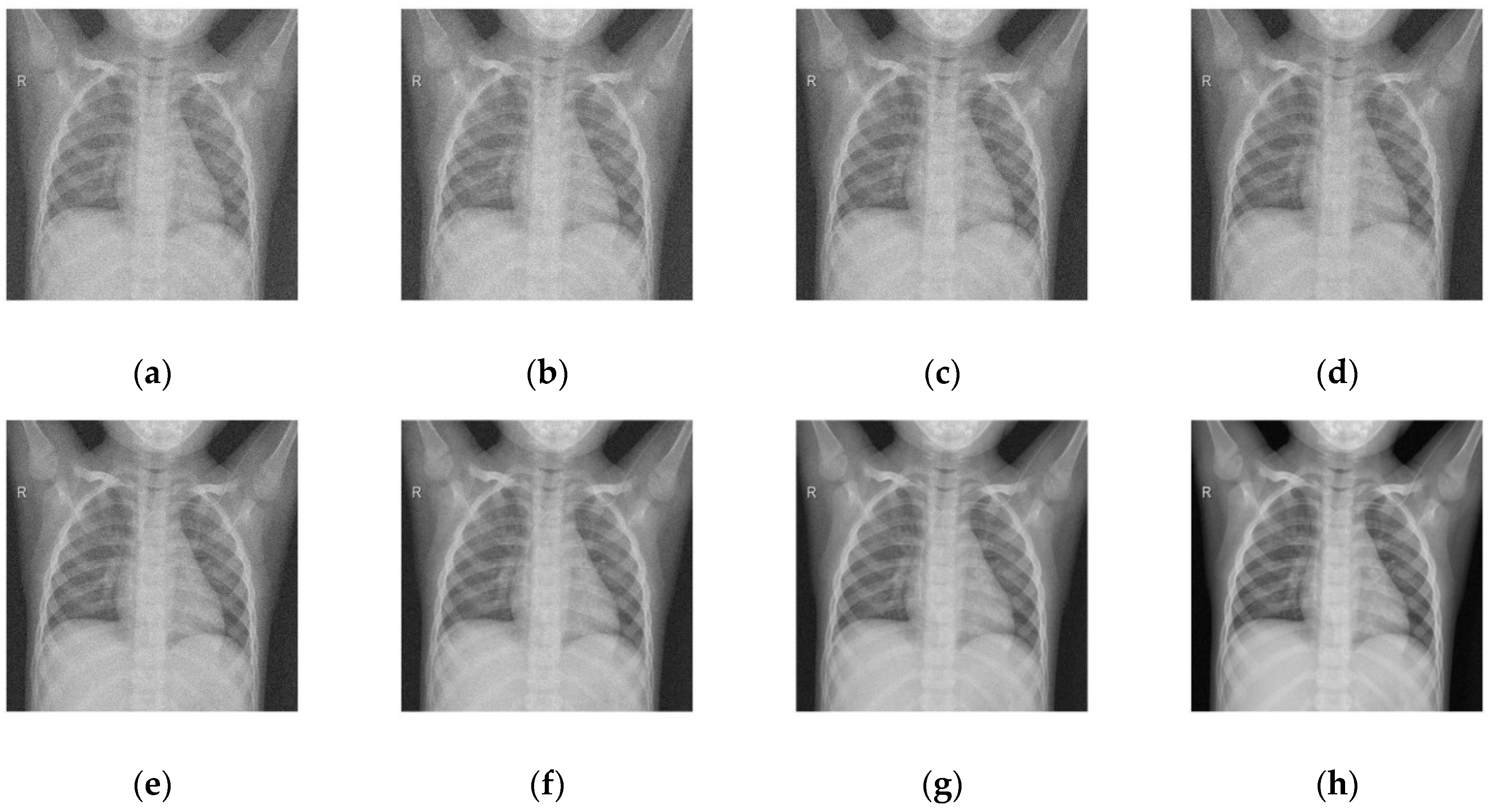
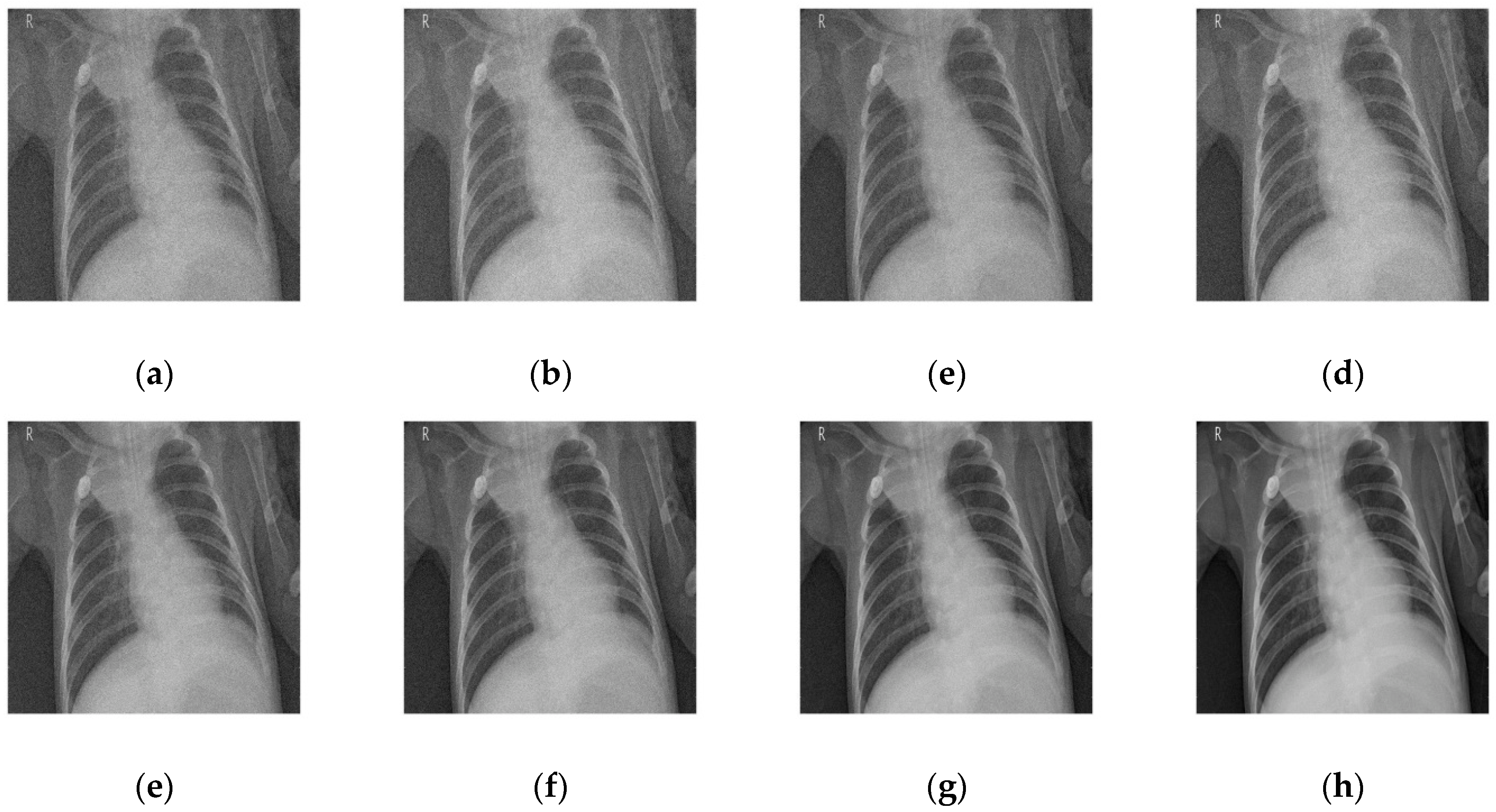
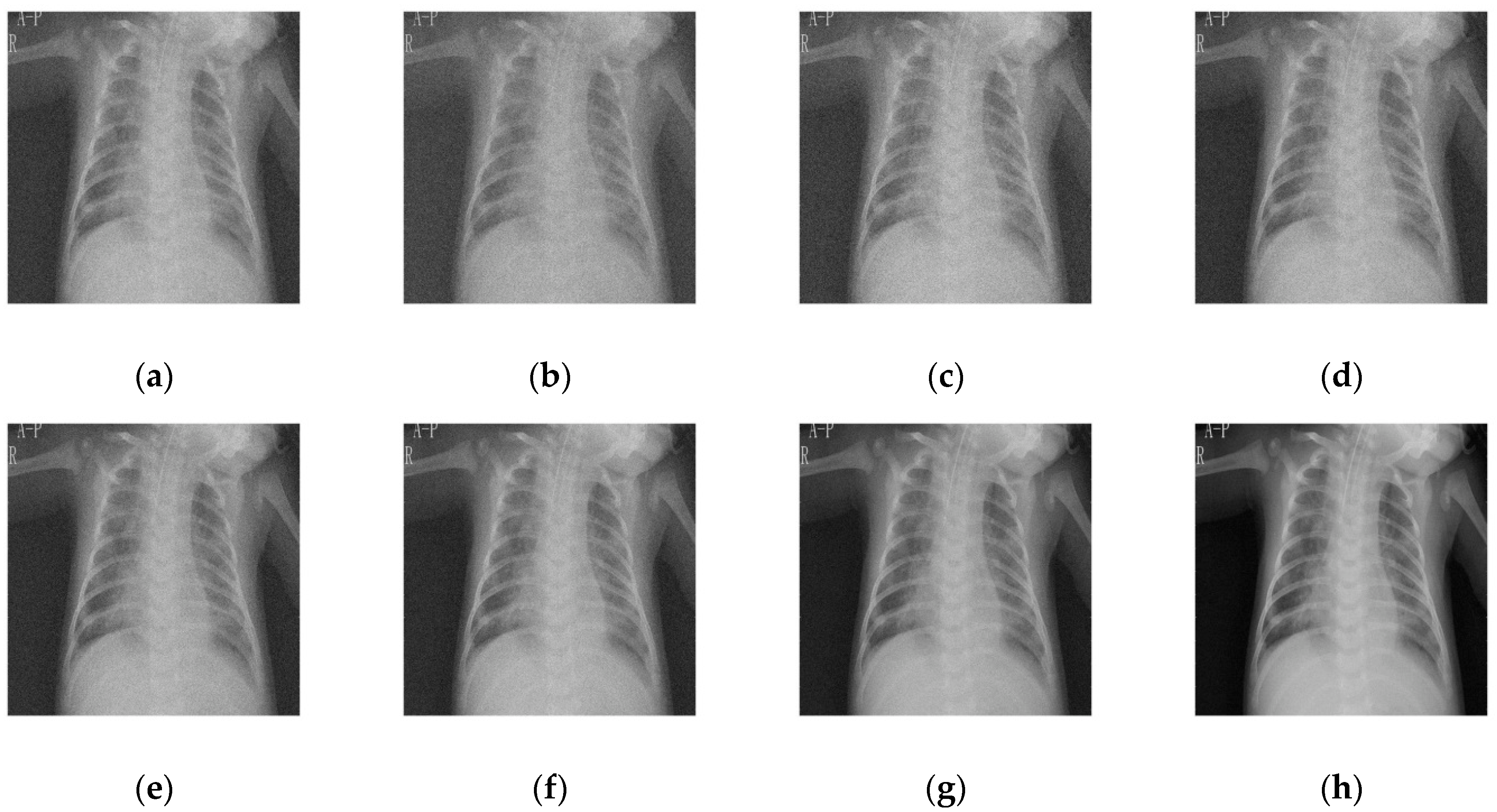

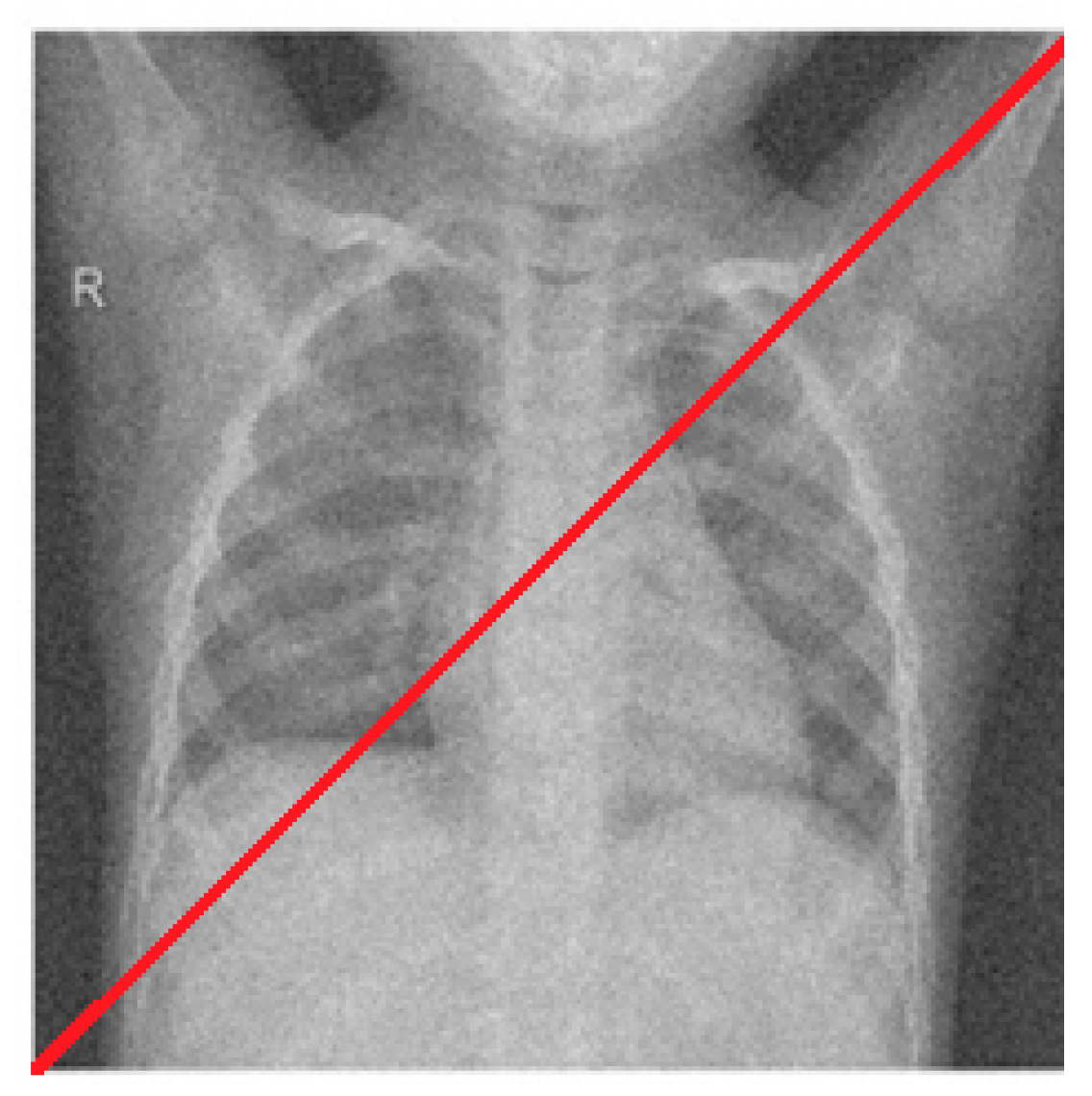

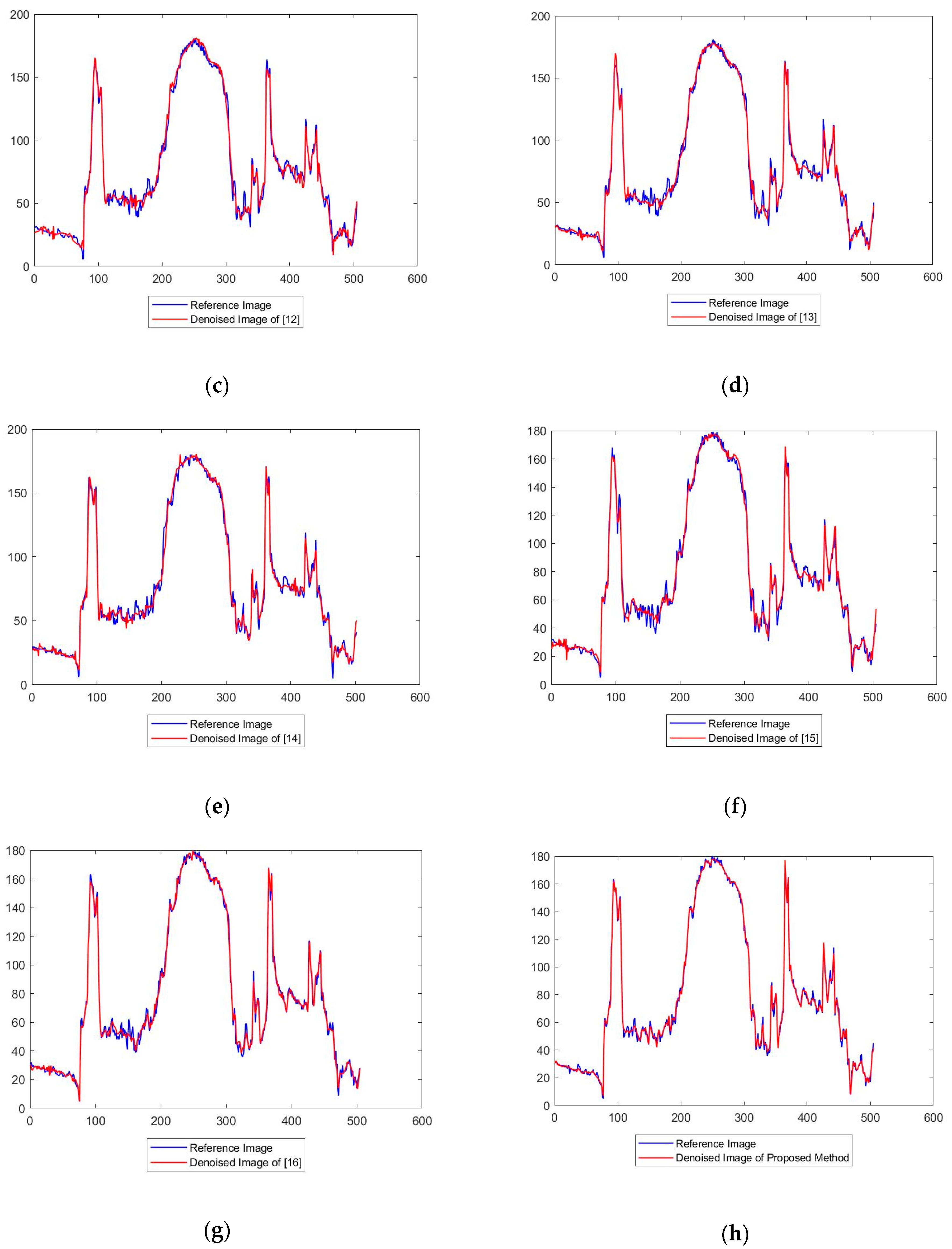
| Proposed Method (without Circular Shifting) | Proposed Method (with Patch-Wise Circular Shifting) | |||||||||
|---|---|---|---|---|---|---|---|---|---|---|
| PSNR | SSIM | PSNR | SSIM | |||||||
| Noise Variance | 3 × 3 | 5 × 5 | 7 × 7 | 9 × 9 | 3 × 3 | 5 × 5 | 7 × 7 | 9 × 9 | ||
| 10 | 28.01 | 0.7408 | 28.3 | 29.4 | 28.8 | 28.5 | 0.7633 | 0.7855 | 0.7534 | 0.7432 |
| 20 | 26.13 | 0.6763 | 26.5 | 27.4 | 27.6 | 26.2 | 0.6933 | 0.7011 | 0.6922 | 6823 |
| 30 | 24.21 | 0.6024 | 24.6 | 25.7 | 25.5 | 24.7 | 0.6124 | 0.6321 | 0.6211 | 0.6121 |
| 40 | 22.03 | 0.5732 | 22.3 | 23.8 | 23.9 | 22.2 | 0.5911 | 0.6062 | 0.5982 | 0.5827 |
| ED | DIV | ED | DIV | |||||||
| 10 | 0.8131 | 0.5741 | 0.4232 | 0.3231 | 0.3123 | 0.4341 | 0.4402 | 0.3132 | 0.4713 | 0.4928 |
| 20 | 1.9312 | 1.6742 | 1.7542 | 1.0341 | 1.1212 | 1.3312 | 1.2336 | 1.0342 | 1.1872 | 1.4342 |
| 30 | 3.6245 | 2.5322 | 3.4521 | 2.9231 | 3.4325 | 3.3225 | 2.1221 | 2.0022 | 2.3211 | 2.2232 |
| 40 | 5.7845 | 4.2215 | 5.1431 | 5.1042 | 5.2511 | 5.4225 | 4.1932 | 4.0315 | 4.1928 | 4.2051 |
| Input | Gaussian Noisy COVID-19 CT Image Dataset 1 (Average Results on 90 Images) | |||||||
|---|---|---|---|---|---|---|---|---|
| PSNR | SSIM | |||||||
| 10 | 20 | 30 | 40 | 10 | 20 | 30 | 40 | |
| [10] | 29.3544 | 27.4356 | 25.3446 | 22.3421 | 0.7344 | 0.6693 | 0.6133 | 0.5993 |
| [11] | 29.4434 | 27.4547 | 25.3426 | 22.23551 | 0.7888 | 0.6674 | 0.6196 | 0.5977 |
| [12] | 29.4425 | 27.3237 | 25.5667 | 22.3423 | 0.7466 | 0.6452 | 0.6104 | 0.5951 |
| [13] | 29.6446 | 27.2334 | 25.2468 | 22.3224 | 0.7343 | 0.6357 | 0.6124 | 0.5918 |
| [14] | 29.2336 | 27.3444 | 25.3458 | 22.7455 | 0.7354 | 0.6432 | 0.6124 | 0.5951 |
| [15] | 29.4547 | 27.5448 | 25.7436 | 22.5635 | 0.7548 | 0.6347 | 0.6154 | 0.5918 |
| [16] | 29.1237 | 27.4553 | 25.5633 | 22.4531 | 0.7355 | 0.6859 | 0.6194 | 0.5905 |
| Proposed | 30.0238 | 28.1339 | 25.1839 | 23.2239 | 0.7972 | 0.6993 | 0.6207 | 0.6021 |
| Input | Gaussian Noisy COVID-19 CT Image Dataset 1 (Average Results on 90 Images) | |||||||
|---|---|---|---|---|---|---|---|---|
| ED | DIV | |||||||
| Σ | 10 | 20 | 30 | 40 | 10 | 20 | 30 | 40 |
| [10] | 0.5821 | 1.3293 | 2.3448 | 3.4533 | 0.3541 | 1.4353 | 2.3443 | 4.3422 |
| [11] | 0.6838 | 1.3464 | 2.2346 | 3.2337 | 0.4438 | 1.4544 | 2.3422 | 4.2355 |
| [12] | 0.3864 | 1.5672 | 2.4564 | 3.4551 | 0.4424 | 1.3232 | 2.5666 | 4.3422 |
| [13] | 0.6828 | 1.1277 | 2.4664 | 3.3228 | 0.6448 | 1.2337 | 2.2464 | 4.3222 |
| [14] | 0.7864 | 1.4372 | 2.5664 | 3.2451 | 0.2334 | 1.3442 | 2.3456 | 4.7454 |
| [15] | 0.7828 | 1.5677 | 2.6434 | 3.3458 | 0.4548 | 1.5447 | 2.7433 | 4.5633 |
| [16] | 0.4855 | 1.6759 | 2.2354 | 3.5625 | 0.1235 | 1.4559 | 2.5632 | 4.4535 |
| Proposed | 0.2982 | 1.0694 | 2.0577 | 3.0121 | 0.0232 | 1.1334 | 2.1832 | 3.2236 |
Publisher’s Note: MDPI stays neutral with regard to jurisdictional claims in published maps and institutional affiliations. |
© 2022 by the authors. Licensee MDPI, Basel, Switzerland. This article is an open access article distributed under the terms and conditions of the Creative Commons Attribution (CC BY) license (https://creativecommons.org/licenses/by/4.0/).
Share and Cite
Diwakar, M.; Singh, P.; Swarup, C.; Bajal, E.; Jindal, M.; Ravi, V.; Singh, K.U.; Singh, T. Noise Suppression and Edge Preservation for Low-Dose COVID-19 CT Images Using NLM and Method Noise Thresholding in Shearlet Domain. Diagnostics 2022, 12, 2766. https://doi.org/10.3390/diagnostics12112766
Diwakar M, Singh P, Swarup C, Bajal E, Jindal M, Ravi V, Singh KU, Singh T. Noise Suppression and Edge Preservation for Low-Dose COVID-19 CT Images Using NLM and Method Noise Thresholding in Shearlet Domain. Diagnostics. 2022; 12(11):2766. https://doi.org/10.3390/diagnostics12112766
Chicago/Turabian StyleDiwakar, Manoj, Prabhishek Singh, Chetan Swarup, Eshan Bajal, Muskan Jindal, Vinayakumar Ravi, Kamred Udham Singh, and Teekam Singh. 2022. "Noise Suppression and Edge Preservation for Low-Dose COVID-19 CT Images Using NLM and Method Noise Thresholding in Shearlet Domain" Diagnostics 12, no. 11: 2766. https://doi.org/10.3390/diagnostics12112766
APA StyleDiwakar, M., Singh, P., Swarup, C., Bajal, E., Jindal, M., Ravi, V., Singh, K. U., & Singh, T. (2022). Noise Suppression and Edge Preservation for Low-Dose COVID-19 CT Images Using NLM and Method Noise Thresholding in Shearlet Domain. Diagnostics, 12(11), 2766. https://doi.org/10.3390/diagnostics12112766






